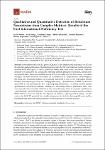Qualitative and Quantitative Detection of Botulinum Neurotoxins from Complex Matrices: Results of the First International Proficiency Test
Worbs, Sylvia
Fiebig, Uwe
Zeleny, Reinhard
Schimmel, Heinz
Rummel, Andreas
Luginbühl, Werner
Dorner, Brigitte
In the framework of the EU project EQuATox, a first international proficiency test (PT) on the detection and quantification of botulinum neurotoxins (BoNT) was conducted. Sample materials included BoNT serotypes A, B and E spiked into buffer, milk, meat extract and serum. Different methods were applied by the participants combining different principles of detection, identification and quantification. Based on qualitative assays, 95% of all results reported were correct. Successful strategies for BoNT detection were based on a combination of complementary immunological, MS-based and functional methods or on suitable functional in vivo/in vitro approaches (mouse bioassay, hemidiaphragm assay and Endopep-MS assay). Quantification of BoNT/A, BoNT/B and BoNT/E was performed by 48% of participating laboratories. It turned out that precise quantification of BoNT was difficult, resulting in a substantial scatter of quantitative data. This was especially true for results obtained by the mouse bioassay which is currently considered as “gold standard” for BoNT detection. The results clearly demonstrate the urgent need for certified BoNT reference materials and the development of methods replacing animal testing. In this context, the BoNT PT provided the valuable information that both the Endopep-MS assay and the hemidiaphragm assay delivered quantitative results superior to the mouse bioassay.
Dateien zu dieser Publikation
Keine Lizenzangabe

